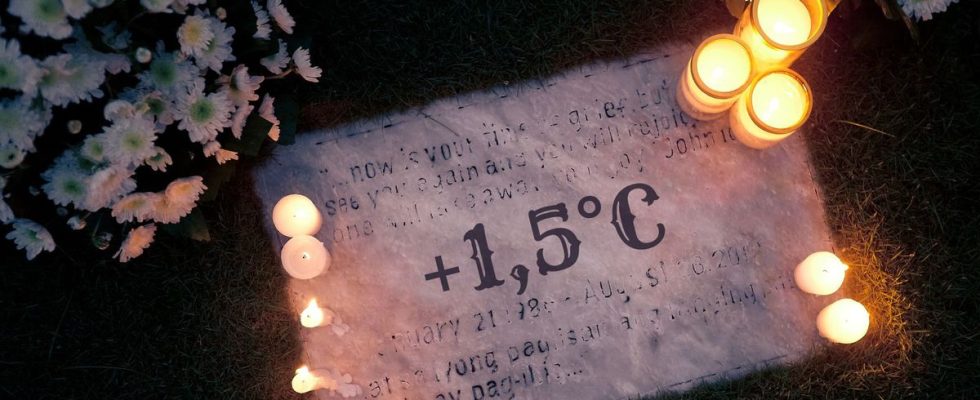Eight years after the Paris Agreement, has the objective of limiting global overheating to 1.5°C been buried? In recent months, temperature records have come one after another faster than attempts in a France-Namibia rugby match. July 2023 struck gold, becoming the hottest month of any month. Then, September 2023 was the hottest on record. All over the globe, global warming brings disasters in its wake. Greece has been battling the largest fire ever recorded in the European Union. Floods swept through China, Slovenia and New York. Day after day, announcements related to climate change approach the daily rhythm. And the promise to limit Earth warming to 1.5°C is slipping away.
“Limiting warming to 1.5°C is illusory,” says François Gemenne, member of the IPCC. “The window of opportunity is really very small because governments are slow to respond to global warming. But the 1.5°C objective is not dead,” replies, more optimistically, Fanny Petitbon, climate expert for the NGO CARE. The year 2023 is already flirting with this fateful limit. Since January, “the global average temperature has been 1.4°C above the pre-industrial average,” the European Copernicus Observatory announced this Thursday.
Already “1.2°C rise on average”
But the year 2023, although exceptional, is not decisive when it comes to determining whether the planet will exceed the 1.5°C mark. Climate analysis is carried out over periods longer than a year and it is based on meteorological analyzes over several decades that the IPCC determines global warming of the planet. “The climate is observed over 20-30 years while the weather is sometimes assessed day by day,” adds Fanny Petitbon.
So, where is the blue planet fever? “Today, we are at 1.2°C of average rise and 1.5°C will probably be reached between 2030 and 2035,” replies François Gemenne, citing IPCC analyses. “We are not on the right trajectory,” regrets Fanny Petitbon who adds that 1.5°C is “a survival limit”. “We are already seeing climate disasters become more and more frequent, but at 1.5°C, the world will face an acceleration and we will enter unknown territory,” she worries.
“It was already dead in 2015! »
On November 4, 2016, the French government hailed a “historic day for the planet” as the Paris climate agreement came into force. “But it was already dead in 2015! », exclaims François Gemenne. “The 1.5°C mark is a marker of political ambition. It’s exactly the same thing as saying: ‘we want zero deaths on the roads'”, berates the IPCC expert who assures that “even if we completely stopped our greenhouse gas emissions today, we would probably be at 1.5°C anyway.”
“The objective of 2 degrees is still achievable, even if it will be extraordinarily difficult. The current rate of warming is 0.2°C over ten years,” underlines the IPCC expert. However, climate experts mandated by the United Nations estimate that beyond 1.5°C, there will be “serious consequences, lasting centuries and sometimes irreversible”. “Today, we are heading towards +3 degrees by the end of the century! If we say that the 1.5°C objective is buried and we count on +2 degrees, we take the risk that States will increase their carbon budget,” alarms Fanny Petitbon, who adds: “staying under the The 2 degree mark is only possible if everyone pitches in.”
“We can no longer bury our heads in the sand”
In the meantime, each year breaks more records than the last. And 2023 has worked hard to bury our hope of a climatic lull. “Records are inevitable. It’s like filling a bathtub with water and coming back punctually and exclaiming “the water has risen!”. If you do not close the tap, it is obvious that the water will continue to flow,” illustrates François Gemenne. If the IPCC expert has little faith in a possible electroshock, it is nonetheless necessary. “We can no longer bury our heads in the sand! We have known for decades and today the countries of the North are much more affected by climate change. There is an issue of protection of these populations,” underlines Fanny Petitbon.
Young people are particularly aware of this emergency and many of them are mobilizing in the hope of saving the planet – and by extension their future, through demonstrations or trials. “We must stop presenting climate action as a list of efforts and renunciations and make structural changes,” underlines François Gemenne. Because even if the objective of staying below 1.5°C is moving further and further away, there is no question of giving up. Global warming is causing (and will cause even more in the future) dramatic dysfunctions in a host of different spheres. “Pollution, health, agriculture, ecosystem… Every tenth of a degree counts,” concludes Fanny Petitbon.

